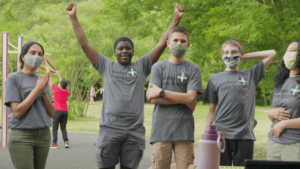Data-driven SEL: How It Can Help Meet Your Students’ Needs

By: Matt Smith and Travita Godfrey
Imagine this scenario: you’re a school counselor and you’ve noticed a change in one of your students. It’s subtle. Perhaps the student is shy and has shared with a teacher that he or she wants to make more friends. You can anecdotally observe the student’s interactions with others but have no specific way to back up what you see.
This is where the problem often arises. Although schools may offer support for students, such as group counseling or other interventions, unless they are able to accurately identify the student’s specific areas of strength and need, it is difficult to successfully support them. This is where data can help. As the teacher, counselor, or principal, it’s important you and your staff have the training to identify what is going on with the student and the right tools to provide the most appropriate interventions.
The Importance of Data
The Collaborative for Academic, Social and Emotional Learning (CASEL) states that adopting an evidence-based SEL program is one of the key strategies for providing consistent SEL opportunities for all students. The use of data—specifically SEL data—is something that we at Humble Independent School District have embraced. We know, for example, if we can pinpoint that a student needs help with optimistic thinking skills then we can adopt strategies to address that specific need, which in the end can help that student tremendously.
Since 2014 we’ve used the DESSA Comprehensive SEL System from Aperture Education. This has been incredibly beneficial in terms of helping to identify students’ specific strengths and needs and also in determining whether our strategies are working. This data can be eye-opening. For example, our assessment data showed us a large percentage of students were struggling with relationship skills. This prompted our school counselors and teachers to refocus their lessons around activities to support this skill.
Using data to pinpoint students’ strengths and needs has been transformative. It has helped our staff provide targeted instruction and strategies for individuals, as well as at the school level, the grade level, and the classroom level. It continues to drive our services to students, and helps us better know who to serve and how.
For example, by using the DESSA-mini, a one-minute universal SEL screener, schoolwide, we are able to determine a campus’s overall SEL learning in order to look for celebrations and also recognize hurdles. By recognizing strengths not only of individuals, but also of classrooms and grade levels, we keep a pulse on the overall climate and culture of a campus.
SEL data also helps us to identify classrooms with particular needs for greater SEL instruction. For instance, when looking at two fourth grade classrooms that are side by side, we may not notice many differences on the surface. Maybe one classroom seems more noisy with engaging activities, or the other seems more quiet and structured, but it’s often hard to really identify the climate of the classroom. By measuring the SEL development of the entire classroom using the data from the DESSA, we’ve been able to identify classrooms that need instruction on self-management, optimistic thinking, or other key skills. This provides an opportunity for the teacher to use the DESSA bank of strategies, or for the school counselor to offer additional guidance lessons to students.
Teachers and schools are now starting to use that SEL data that is collected in order to group classrooms for the upcoming year. It’s important to have a well-rounded classroom of students so that students can build on their various strengths while also drawing on the strengths of others. The DESSA System and the data that it provides helps us to do that and we hope to continue even more deeply in the future!
The Humble Approach
When it comes to addressing students’ SEL skills, data is an important part of the puzzle, but a school still needs the other pieces to complete the picture. Our “Great 8” SEL initiative encompasses everything from staffing to curriculum adoption to training. We focus on the eight SEL competencies outlined by Aperture Education: self-awareness, social awareness, self-management, relationship skills, goal directed behavior, personal responsibility, decision making, and optimistic thinking.
Being a large suburb just outside of Houston, it is not uncommon for our students to attend multiple schools throughout their educational journey. With this in mind, we believed we needed a consistent SEL curriculum that mirrored our academic learning. Just as our math curriculum has a scope and sequence, so does our SEL curriculum. Counselors and teachers focus on teaching one skill across all grade levels each quarter so that over the course of two years, students have been exposed to all eight skills. Strategies build on themselves because we know that while decisions are different for a 4th grader and a 9th grader, developing decision making skills is a constant need no matter the age.
We also offer professional development workshops that are rooted in the Great 8, and we have behavior specialists to lead, support, and implement our program. In the elementary grades, we have “Class Connections” and “Community Time” during which teachers have conversations related to our Great 8 Skills. Our middle schools and high schools select an eighth and 12th grade boy and girl that exemplify the Great 8 skills. The students, who are selected by their peers, are honored at a luncheon and awarded certificates, and the 8th graders become part of our Superintendent’s Student Advisory Council for their entire four years of high school.
We also use Positive Behavior Intervention and Supports (PBIS), and the “Why Try” program to foster a safe environment in which all students can learn, and the PBIS system creates a seamless model for SEL instruction and measurement to occur.
This district-wide approach helps to ensure students get the support they need. We’ve had incredible success with this. In our elementary school pilot, the number of discipline referrals dropped from 161 to 80 after we introduced the SEL model. We attribute this to our use of data and our robust SEL programs to support students’ needs.
Going back to the original scenario of helping the shy student who wants to make more friends, here’s how we would handle it.
- Assess the student’s SEL competencies. The DESSA helps us to identify the student’s specific strengths and needs and target specific intervention strategies.
- Do one-on-one or small-group work with the student on the skills he or she needs help with. If several students have been assessed and the data shows multiple students need support with the same skill, we would consider adding classroom lessons around that skill.
- Provide suggestions for the student’s parents about strategies they can try at home.
- Re-assess the student to determine if the strategies are working.
The Importance of Having the Right Strategies
The DESSA System provides hundreds of strategies created by teachers, for teachers, that schools can use to teach specific SEL skills, and we’ve also created some of our own. We recently earned an award for a video we created discussing our use of the DESSA SEL strategies.
Going back to the student we’ve been discussing. Say he or she is in second or third grade and our assessment identified optimistic thinking as a skill in need of support. Here is a specific example of a strategy we use with our second and third grade students to address this skill. First we have students read the book “Your Fantastic Elastic Brain” and watch a video on the topic. Then we have a discussion about what they can do if things don’t go how they planned, and what they should do next time this happens. Our strategies usually include a video, a book or music, and our students are still reminding one another of the power of yet. When a student says ‘I can’t do this math,’ it is not uncommon to hear another student chime in saying, ‘you can’t do this math YET!’
In another example, a lot of our elementary school students need support with self-management skills. We teach them a five-point scale to help them recognize their triggers and what they can do to calm themselves and get themselves regulated. We might also do small group sessions with the students to help them practice those self-management skills.
The bottom line is that the best way, in our experience, to help a student who may be struggling is by obtaining data to get to the root of the problem and then deploying targeted strategies to address that student’s specific needs. Taking these steps will shed light on concerns that otherwise might stay undetected. They can help build protective factors that will ultimately set the student up for a lifetime of success.
For more, see:
- SEL in the Era of COVID-19
- CASEL’s New Guide Provides Actionable Steps for SEL Implementation
- Social Emotional Learning and the Future of Education
Matt Smith is the Coordinator of Elementary Counseling and Behavioral Services and Homeless Liaison at Humble ISD.
Travita Godfrey is the Coordinator of Secondary Counseling and Behavior Services at Humble ISD.
Stay in-the-know with innovations in learning by signing up for the weekly Smart Update.






0 Comments
Leave a Comment
Your email address will not be published. All fields are required.